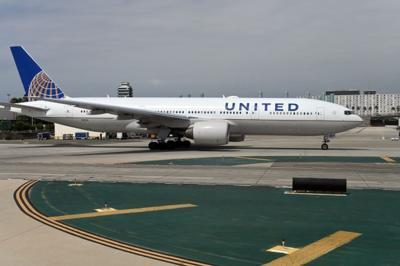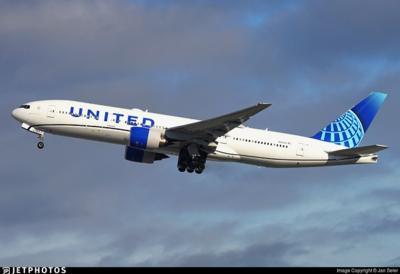A Matter of Degrees
The NTSB has released its final report on a 18 December 2022 incident in which a 23-year-old United Airlines Boeing 777-222, registration N212UA, then operating as UAL Flight 1722, experienced a dramatic altitude deviation enroute from the Hawaiian island of Maui’s Kahului Airport (OGG) to California’s San Francisco International Airport (SFO).

The flight was operated as a scheduled air-carrier operation under Part 121 of the Federal Aviation Regulations.
United Airlines Flight 1722 lost altitude approximately one-minute after departing Maui’s Kahului Airport (OGG) in Instrument Meteorological Conditions (IMC). The Boeing 777-222 descended from an altitude of 2,100-feet MSL to approximately 745-feet above the waters of the South Pacific Ocean before the aircraft’s crew arrested the descent and recovered the aircraft to a normal climb attitude.
The aircraft sustained no damage; nor was a single injury reported among the flight’s 271 passengers and ten crew-members.
The NTSB was not initially notified of the event insomuch as it did not meet the requirements of Part 830.5, which requires operators of civil aircraft to immediately, and by the most expedient means available, notify the nearest National Transportation Safety Board office in the event of 12 occurrences comprehensively described in the rule.
The NTSB learned of the event approximately two-months after its occurrence and opted to open an investigation. By that time, however, the aircraft’s Cockpit Voice Recorder (CVR) and Flight Data Recorder (FDR) had overwritten data germane to the instance. Ergo, the agency predicated its investigation primarily upon crew statements and air-carrier and ATC records.
The 55-year-old, 19,600-hour, ATP certificated and Boeing 777 type-rated Pilot In Command (PIC/captain) flying the aircraft at the time of the altitude excursion, stated he and the Second In Command (SIC/first officer) had calculated takeoff performance and planned, initially, for a flaps-20 takeoff (flap setting of twenty-degrees) with a reduced-thrust setting. However, during taxi, the ground controller advised the air-crew that low-level windshear advisories were in effect.
Based on the antecedent information, the PIC chose a flaps-20 maximum thrust takeoff and hand-flew such with the aircraft’s auto-throttles engaged. The 777’s rotation and initial climb were normal; however, as the ascent continued, the flight-crew noted airspeed fluctuations as the aircraft encountered turbulence. When the 777 reached acceleration altitude, the captain reduced the pitch attitude slightly and called for the flap setting to be reduced to flaps-5.
The SIC stated he thought he’d heard the PIC call for flaps-15, which the SIC selected prior to contacting departure control and discussing the prevailing weather conditions. The PIC noticed the aircraft’s maximum operating speed indicator had moved to a lower value than expected. Thereafter, the 777’s airspeed began to increase rapidly.
To avoid a flap overspeed, the PIC reduced engine thrust manually, overriding the auto-throttle servos, and began diagnosing the flap condition. The PIC noticed the flap-indicator showing 15-degrees, and again called for flaps-5—this time confirming the SIC moved the flap-handle to the five-degree position.
The SIC stated he “knew the captain was having difficulty with airspeed control,” and queried the PIC regarding such as he contemporaneously considered the possibility his own (right-side) instrumentation may have been in error. The SIC did not receive an immediate response from the PIC. Both pilots recalled the aircraft’s pitch attitude—at about that time—was decreasing, and its airspeed increasing. The SIC recalled the PIC asked for flaps-1 soon after he’d called for flaps-5. The SIC recalled, also, that his resetting of the flaps to one-degree occasioned further increase of the 777’s airspeed and forward movement of the cockpit control-columns.

Both pilots recalled hearing warnings from the aircraft’s Ground Proximity Warning System (GPWS); the SIC recalled announcing “pull up pull up” as the GPWS warning sounded. The PIC stated he subsequently pulled aft on his control column, reduced power to reduce airspeed, then applied full-power for purpose of “beginning the full CFIT [Controlled Flight Into Terrain] recovery.” The SIC further recalled that, as the PIC was performing the recovery, the GPWS again alerted as the descent was arrested and began to reverse trend. Data showed the aircraft descended to within 748-feet of the ocean’s surface.
Noting a positive rate of climb, the PIC lowered the aircraft’s nose to a normal climb pitch, ensured the flaps and speed-brakes were fully retracted, and engaged the autopilot. The remainder of the flight was uneventful.
The occurrence compelled United Airlines to modify one of its operations training modules to address the incident and initiate an awareness campaign pertaining to flight-path management.
The National Transportation Safety Board determined the altitude deviation was likely attributable to the flight-crew’s failure to manage the aircraft’s vertical flightpath, airspeed, and pitch-attitude following a miscommunication vis-a-vis the climb flap-setting desired by the PIC.
Parties seeking additional information pertaining to the described incident should reference NTSB Incident Number DCA23LA172.
 Bolen Gives Congress a Rare Thumbs-Up
Bolen Gives Congress a Rare Thumbs-Up The SportPlane Resource Guide RETURNS!!!!
The SportPlane Resource Guide RETURNS!!!! Buying Sprees Continue: Textron eAviation Takes On Amazilia Aerospace
Buying Sprees Continue: Textron eAviation Takes On Amazilia Aerospace Hawker 4000 Bizjets Gain Nav System, Data Link STC
Hawker 4000 Bizjets Gain Nav System, Data Link STC Echodyne Gets BVLOS Waiver for AiRanger Aircraft
Echodyne Gets BVLOS Waiver for AiRanger Aircraft




